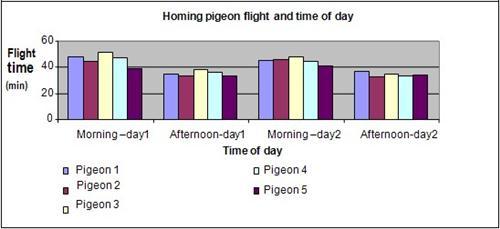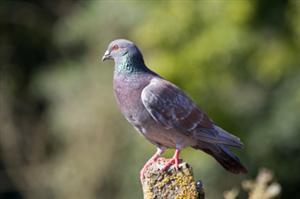| Complexity level: | 7 |
| Project cost ($): | 30 |
| Time required: | It will take an hour to prepare for this science project, and 2 days for observation. |
| Material availability: | Contact a pigeon breeder. You will need one who can supply the pigeons for the experiment. |
| Safety concerns: | Keep your hands clean before and after handling the pigeons. Pigeon waste is highly toxic. |
Hypothesis
The flight time of the homing pigeon is not affected by the time of the day.
Overview
Homing pigeons
Homing pigeons are a type of domesticated pigeons that are selectively bred from Rock pigeons. These pigeons have an innate ability to find their way home to their nest over long distances. They have been recorded to travel as far as 1800km in pigeon racing competitions. The pigeons are also able to fly at speeds between 48km/hour and 95km/hour.
The ability of homing pigeons to always find their way home makes homing pigeons good message carriers; this is why homing pigeons are also known as carrier pigeons. 3000 years ago, Persians and Egyptians used carrier pigeons to send messages. The first pigeon postal service took off in 1896, with pigeons journeying from New Zealand to the Great Barrier Island.
It is important to train homing pigeons when they are young in order for them be comfortable around humans. Homing pigeons are usually housed in pigeon holes or lofts. A pigeon trainer would normally take them on short trips when they are about 6 months old. Then, the trainer would release them; to allow them to find their way back home. On average, a pigeon remain in service for between 2 to 3 years.
Scientific Terms
Materials
The materials required for the experiment are as follows:
- 5 homing pigeons. Select 5 trained homing pigeons that are about 1 year old each.
- 1 car
- 1 cage for the pigeons
- an assistant
- 2 cell phones
- a stop watch
Procedure
1. For this experiment, the independent variable is the time of the day when the pigeon is released to return home – ie: in the morning or in the afternoon. The dependent variable is the amount of time taken by the pigeons to fly back home. Use a stopwatch to time them. The constants (control variables) are the distance traveled by the homing pigeons, the pigeons’age and the weather conditions.
2. On the morning of the first day of the experiment, place the 5 homing pigeons in a cage. Drive to a location about 20 kilometers away. An assistant should be waiting near the pigeons’ home with a cell phone and a stopwatch.
3. Before releasing the pigeons, the assistant is to standby with the stopwatch. The assistant needs to wait near the nest of the homing pigeons. Start the stopwatch when the pigeons are released. Record how long it takes for the pigeons to find their way home in the table below.
4. Repeat procedures number 3 and 4 in the afternoon, at the same location.
5. Repeat procedures number 2,3 and 4 the next day.

Results
The pigeons were able to find their way home more quickly in the afternoon than in the morning.
| Condition | Time the pigeons take to fly home (minutes) | ||||
| Pigeon 1 | Pigeon 2 | Pigeon 3 | Pigeon 4 | Pigeon 5 | |
| Morning –day1 | 48 | 44 | 51 | 47 | 39 |
| Afternoon-day1 | 35 | 33 | 38 | 36 | 33 |
| Morning –day2 | 45 | 46 | 48 | 44 | 41 |
| Afternoon-day2 | 37 | 32 | 35 | 33 | 34 |
Use the graph below to plot your results

Conclusion
The hypothesis that the flight time of the homing pigeon is not affected by the time of the day is proven to be false. The pigeons found their way home more quickly in the afternoon than in the morning
Pigeon racing took off because people were interested in comparing how much time different homing pigeons take to return home. In such races, pigeons were brought to a specific location and released at the same time. The first pigeon to find its way back home will be declared the winner.
Also consider
Conduct the experiment in different weather conditions (a sunny, cloudy, windy or rainy day).
How long do the pigeons take to find their way home in the day? How long do they take at night? .
References
Homing pigeons - http://en.wikipedia.org/wiki/Homing_pigeon
What are homing pigeons? - http://www.wisegeek.com/what-are-homing-pigeons.htm
Pigeon facts - http://www.fbipigeons.com/PIGEON%20FACTS.htm

